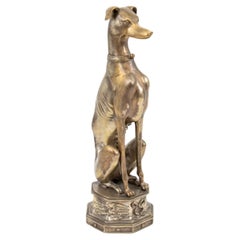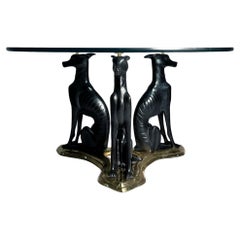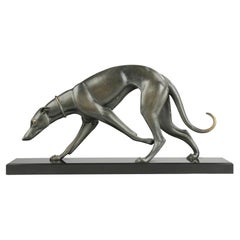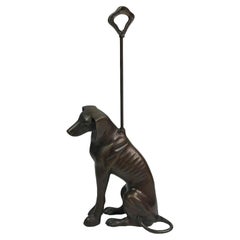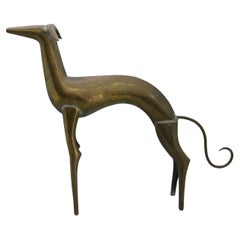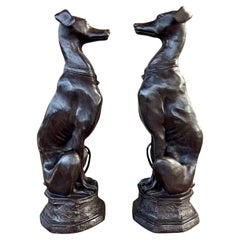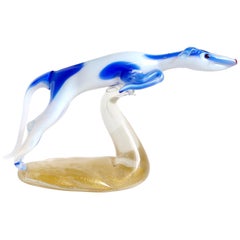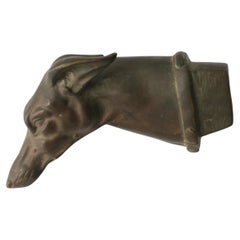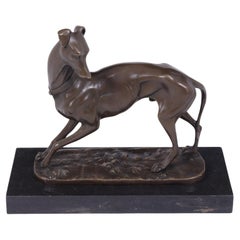Art Deco Whippet
Early 20th Century Italian Art Deco Center Tables
Mahogany
Early 20th Century Art Deco Animal Sculptures
Brass
Late 20th Century American Art Deco Coffee and Cocktail Tables
Brass
Vintage 1920s French Art Deco Animal Sculptures
Belgian Black Marble, Spelter
Early 20th Century French Art Deco Animal Sculptures
Belgian Black Marble, Bronze
Vintage 1960s German Art Deco Animal Sculptures
Metal, Bronze
Late 20th Century Unknown Art Deco Animal Sculptures
Bronze
Early 20th Century French Animal Sculptures
Brass
Late 20th Century Animal Sculptures
Bronze
Mid-20th Century Italian Art Deco Animal Sculptures
Gold Leaf
Early 20th Century French Art Deco Animal Sculptures
Bronze
Recent Sales
20th Century English Art Deco Animal Sculptures
Silver Leaf
Antique 1880s French French Provincial Animal Sculptures
Bronze
Vintage 1930s Unknown Art Deco Bookends
Steel
20th Century Art Deco Garden Ornaments
Concrete
Early 20th Century Art Deco Animal Sculptures
Metal, Chrome
20th Century American Andirons
Nickel, Iron
Mid-20th Century French Art Deco Animal Sculptures
Marble, Bronze
Early 20th Century Austrian Art Deco Barware
Silver Plate
Early 20th Century Figurative Sculptures
Metal
Vintage 1940s English Art Deco Figurative Sculptures
Bronze
Vintage 1930s Clocks
Onyx, Bronze
Mid-20th Century Art Deco Animal Sculptures
Bronze
Vintage 1920s Unknown Art Deco Animal Sculptures
Brass
Vintage 1930s American Art Deco Table Lamps
Vintage 1960s German Art Deco Animal Sculptures
Metal, Bronze
Early 20th Century Art Deco Decorative Dishes and Vide-Poche
Iron, Steel, Metal
Late 20th Century French Art Deco Animal Sculptures
Marble, Bronze, Brass
Late 20th Century Unknown Art Deco Animal Sculptures
Bronze
20th Century French Art Deco Table Lamps
Bronze
Vintage 1950s Unknown Art Deco Animal Sculptures
Cast Stone
20th Century Unknown Art Deco Animal Sculptures
Bronze
Vintage 1980s Hong Kong Art Deco Coffee and Cocktail Tables
Brass, Bronze
Vintage 1920s Art Deco Animal Sculptures
20th Century French Sculptures
Marble, Onyx
Vintage 1920s American Art Deco Animal Sculptures
Bronze
People Also Browsed
Antique 19th Century English Chinese Chippendale Vitrines
Glass, Mahogany
Antique Late 19th Century European Moorish Architectural Elements
Wrought Iron
Vintage 1960s Italian Mid-Century Modern Animal Sculptures
Majolica, Terracotta
Mid-20th Century Mid-Century Modern Animal Sculptures
Bronze
21st Century and Contemporary Vietnamese George II Dry Bars
Wood
20th Century Animal Sculptures
Bronze
Antique Early 18th Century French Baroque Western European Rugs
Wool, Silk
Vintage 1980s Unknown Hollywood Regency Animal Sculptures
Bronze
Vintage 1940s Animal Sculptures
Composition
Antique Late 19th Century French Art Nouveau Animal Sculptures
Bronze
Early 20th Century French Art Deco Animal Sculptures
Belgian Black Marble, Spelter
Mid-20th Century English Renaissance Beds and Bed Frames
Oak
20th Century Animal Sculptures
Bronze
Vintage 1970s Philippine Animal Sculptures
Bronze
Antique Mid-19th Century English High Victorian Taxidermy
Other
Vintage 1950s Animal Sculptures
Terracotta
Art Deco Whippet For Sale on 1stDibs
How Much is a Art Deco Whippet?
- What is the history of Art Deco?1 Answer1stDibs ExpertMarch 25, 2024The history of Art Deco begins in the early 20th century.
Art Deco emerged as a global design style around the start of World War I, during the last years of Art Nouveau's popularity. The style conjures visions of the Roaring Twenties, Machine Age metropolises, vast ocean liners, sleek typography and Prohibition-era hedonism. Its hallmarks include the use of geometric designs influenced by Cubism. Major discoveries of Egyptian tombs during the era also influenced the movement.
The term Art Deco derives from the name of a large decorative arts exhibition, the Exposition Internationale des Arts Décoratifs et Industriels Modernes, held in Paris in 1925. After World War II, tastes shifted toward more functional, less ornate modernism, but today, the Art Deco style is still favored for its luxurious sophistication. On 1stDibs, shop a large selection of vintage Art Deco furniture. - What defines Art Deco?1 Answer1stDibs ExpertApril 5, 2024A few things define Art Deco. Date is one factor, as the style emerged in the 1920s and remained popular during the 1930s. Art Deco design usually includes bold geometric lines and forms or intricate repeating floral motifs. Designers working in this style tended to use expensive materials, such as shagreen or marble, as well as exotic woods like mahogany, ebony and zebra wood. Furniture often featured metal accents, mirrored finishes and embellishments made from exotic animal hides and inlays of mother-of-pearl or ivory. Shop a wide range of Art Deco furniture on 1stDibs.
- What is an Art Deco lamp?1 Answer1stDibs ExpertApril 5, 2022An Art Deco lamp is any lamp that’s made in the styles of the Art Deco movement, which was dominant in the 1920s and 1930s. On 1stDibs, you’ll find a collection of Art Deco lamps from some of the world’s top sellers.
- What is art deco ring?1 Answer1stDibs ExpertAugust 17, 2021Art Deco rings were made during the early 20th century. Named for a design movement that originated at a large decorative arts exhibition held in Paris in 1925, Art Deco rings are generally quite geometric, symmetrical and incorporate a variety of gemstones — especially sapphires and emeralds. Find a wide variety of Art Deco rings for sale on 1stDibs.
- When did Art Deco originate?1 Answer1stDibs ExpertFebruary 1, 2024The Art Deco period originated in France. Its name comes from the title of a large decorative arts exhibition held in Paris in 1925, credited with introducing the style to the world. It was informed by ancient Egypt, Cubism, Futurism, Louis XVI, De Stijl, modernism and the Vienna Secession and went on to influence the Streamline Moderne and mid-century modern movements. Shop a wide range of Art Deco furniture, decorative objects and jewelry on 1stDibs.
- What was Art Deco influenced by?1 Answer1stDibs ExpertMay 3, 2024Art Deco was influenced by a number of things. The discovery of ancient tombs around the turn of the century led to a renewed interest in Egyptian furniture and architecture that inspired Art Deco designers. Art Deco was also informed by Cubism, Futurism, Louis XVI style, De Stijl, modernism and the Vienna Secession. Shop a large collection of Art Deco furniture, decorative objects and jewelry on 1stDibs.
- How do I identify Art Deco?1 Answer1stDibs ExpertApril 5, 2022To identify Art Deco, look for the characteristics of the period. Furniture produced at the time is generally lacquered metal with a mirror-like glossy finish. Wooden items should be an exotic wood. Most items feature symmetrical designs, and geometric forms were popular motifs during the period. In addition, Art Deco often shows the influence of Hellenistic, Egyptian and Asian designs. Shop a variety of Art Deco furniture and decorative objects on 1stDibs.
- What was the Art Deco movement?1 Answer1stDibs ExpertMay 30, 2024The Art Deco movement was a decorative style popular during the 1920s and ’30s. Few design styles are as universally recognized and appreciated as Art Deco. The term alone conjures visions of the Roaring Twenties, Machine Age metropolises, vast ocean liners, sleek typography and Prohibition-era hedonism. The iconic movement made an indelible mark on all fields of design, celebrating society's growing industrialization with refined elegance and stunning craftsmanship. Widely known designers associated with the Art Deco style include Émile-Jacques Ruhlmann, Eileen Gray, Maurice Dufrêne, Paul Follot and Jules Leleu. The term Art Deco derives from the name of a large decorative arts exhibition held in Paris in 1925. On 1stDibs, shop a wide range of Art Deco furniture and decorative objects.
- What is an art deco watch?1 Answer1stDibs ExpertApril 5, 2022An art deco watch is defined by its geometric case, which is either circular or rectangular. The watch style was highly popular between 1920 and 1950, and is still sought after today. You’ll find a collection of art deco watches from some of the world’s top sellers on 1stDibs
- What is art deco jewelry?1 Answer1stDibs ExpertFebruary 22, 2021Art Deco jewelry was popular during the design movement of the 1920s and 30s. Art Deco jewelry is typically characterized by geometric patterns and gemstones of contrasting colors.
- 1stDibs ExpertAugust 15, 2019
The main difference between Art Nouveau and Art Deco is that the former is detailed and ornate, and the latter is sharp and geometrical. When the movement started at the end of the 19th century, Art Nouveau was heavily influenced by nature and the curved lines of flowers. Art Deco, which became popular in the beginning of the 20th century, was inspired by the geometric abstraction of cubism.
- 1stDibs ExpertAugust 26, 2024The difference between Art Deco and mid-century modern (MCM) is that the terms describe two distinct design styles. Art Deco typically refers to pieces produced between the 1920s and 1930s. Furniture produced in this style tends to display bold geometric lines and forms, floral motifs, metal accents, shimmering mirrored finishes and embellishments made from exotic animal hides, inlays of mother-of-pearl or ivory. MCM, or mid-century modern, emerged after World War II. Organically shaped, clean-lined and elegantly simple are three terms that well describe vintage mid-century modern furniture. Designers working in this style frequently used industrial materials, including steel, fiberglass, molded plywood, and alluring woods such as teak, rosewood and oak. Explore a wide variety of Art Deco and mid-century modern furniture on 1stDibs.
- Was Eileen Gray Art Deco?1 Answer1stDibs ExpertFebruary 21, 2024The answer to whether Eileen Gray's designs were Art Deco depends on which piece you're considering. Gray was ever-evolving as a designer. By the early 1920s, she was creating geometric works that embodied the essence of Art Deco and the nascent modernist design movement. Some pieces, like her Bricks screen, employ the planar forms favored by Gerrit Rietveld and other De Stijl architects of the Netherlands. Others feature the tubular chrome framing used by Marcel Breuer and Ludwig Mies van der Rohe, who are associated with the mid-century modern design style. On 1stDibs, shop a variety of Eileen Gray furniture.
- 1stDibs ExpertAugust 15, 2019
The main features of Art Deco are geometry-influenced shapes, bright color schemes and bold patterns. Art Deco architecture and design are both heavily influenced by the Cubism movement, which relied on the use of non-traditional angles and shapes.
- 1stDibs ExpertSeptember 25, 2019
Art Deco features bold geometric designs, clean lines and vibrant colors.
- 1stDibs ExpertAugust 15, 2019
Art Deco style furniture appeared right before the start of World War I and is defined by sharp lines, vibrant colors and bold patterns. Heavily influenced by geometry, Art Deco furniture was born out of the Cubism movement.
- 1stDibs ExpertFebruary 27, 2024To identify Art Deco furniture, first look for maker's markings in inconspicuous areas. Once you've found them, use trusted online resources to research the manufacturer and determine whether they were active during the Art Deco era, which spanned from the 1920s through the 1930s. You can also look for classic characteristics of Art Deco furniture, such as bold geometric lines and forms, intricate floral motifs, metal accents, mirrored finishes and fine materials such as shagreen, marble, mahogany wood, zebra wood, ebony, exotic animal hides, onyx and mother-of-pearl. A certified appraiser or knowledgeable antiques dealer can also assist you with making identifications. Shop a collection of Art Deco furniture on 1stDibs.
- Is Art Deco jewelry valuable?1 Answer1stDibs ExpertFebruary 1, 2024Yes, some Art Deco jewelry is valuable. Jewelry from the 1920s and ’30s has remained consistently popular. It experienced a major revival in the 1960s, and even today, jewelry makers continue to be inspired by the period. As a result, demand for Art Deco jewelry is typically high, but the actual value of a piece depends on its style, maker, age and condition. A certified appraiser or experienced antiques dealer can help you determine how much your jewelry is worth. Explore a large selection of Art Deco jewelry on 1stDibs.
- 1stDibs ExpertNovember 8, 2023Art Deco engagement rings are accessories that were produced during the 1920s and '30s and are characterized by details associated with the Art Deco style. They're often very colorful and feature bold geometric lines as well as gemstones cut in nontraditional ways. While the style got its name from an arts exhibition in Paris in 1925, Art Deco was inspired by Cubism and a shift from Art Nouveau's floral aesthetic. The modern look of Art Deco engagement rings reflects an evolution in fashion, visual art and more, as well as the sweeping societal changes taking hold at the time. On 1stDibs, shop a range of vintage Art Deco engagement rings.
- What are art deco lamps made of?1 Answer1stDibs ExpertApril 5, 2022Art deco lamps come in a variety of shapes, sizes and styles. Vintage art deco-style lamps were made of natural materials such as metal, glass and pottery. You’ll find a variety of art deco lamps from some of the world’s top sellers on 1stDibs.

